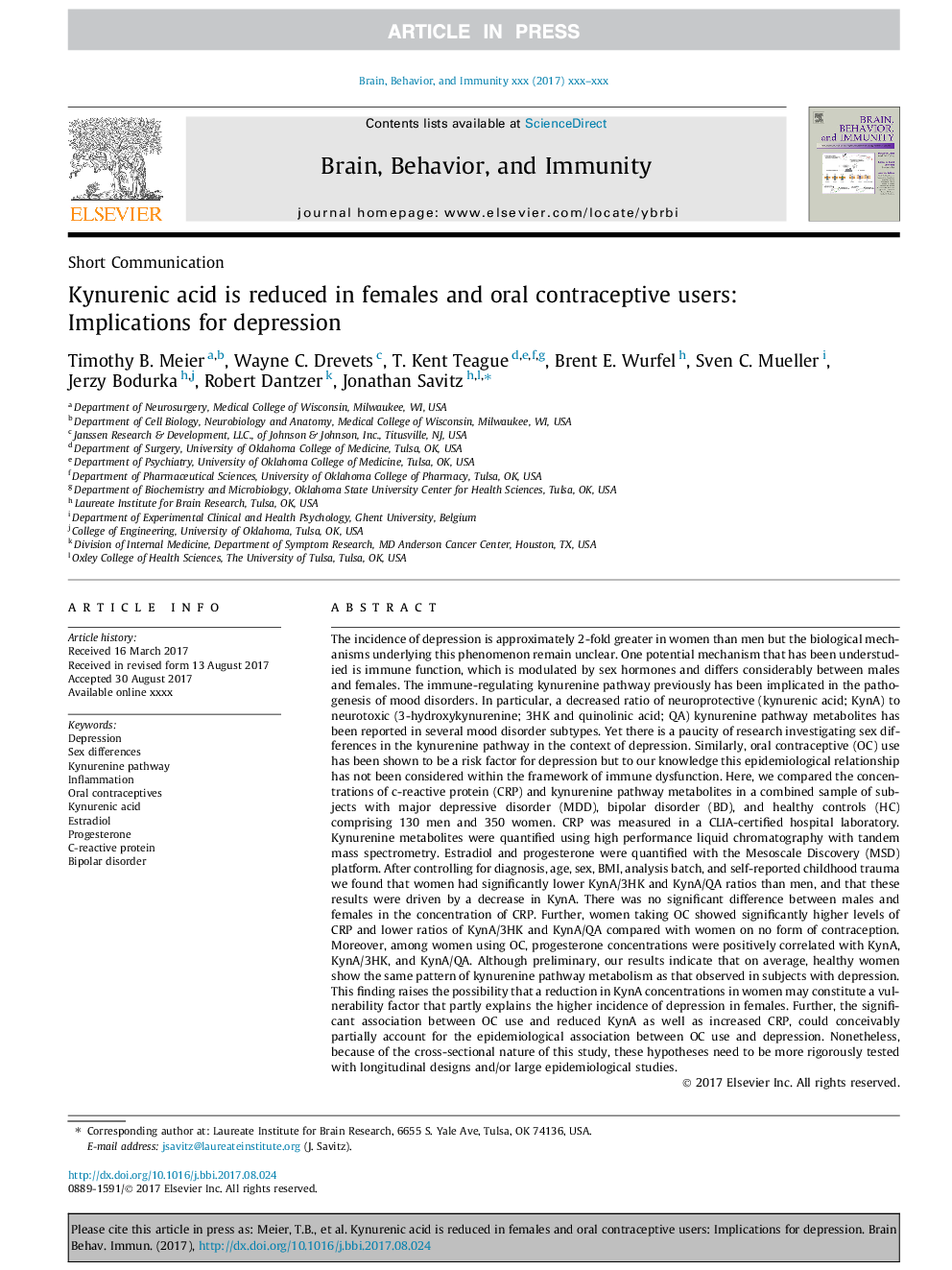| کد مقاله | کد نشریه | سال انتشار | مقاله انگلیسی | نسخه تمام متن |
|---|---|---|---|---|
| 7279679 | 1473899 | 2018 | 6 صفحه PDF | دانلود رایگان |
عنوان انگلیسی مقاله ISI
Kynurenic acid is reduced in females and oral contraceptive users: Implications for depression
ترجمه فارسی عنوان
اسید کینورنیک در زنان و مصرف کنندگان پیشگیری از بارداری کاهش می یابد: پیامدهای افسردگی
دانلود مقاله + سفارش ترجمه
دانلود مقاله ISI انگلیسی
رایگان برای ایرانیان
کلمات کلیدی
bipolar disorder - اختلال دو قطبیEstradiol - استرادیولkynurenic acid - اسید کینورنیکDepression - افسردگیinflammation - التهاب( توروم) Sex differences - تفاوت های جنسیتیkynurenine pathway - مسیر kynurenineC-reactive protein - پروتئین واکنشی سیProgesterone - پروژسترونoral contraceptives - پیشگیری از بارداری خوراکی
موضوعات مرتبط
علوم زیستی و بیوفناوری
ایمنی شناسی و میکروب شناسی
ایمونولوژی
چکیده انگلیسی
The incidence of depression is approximately 2-fold greater in women than men but the biological mechanisms underlying this phenomenon remain unclear. One potential mechanism that has been understudied is immune function, which is modulated by sex hormones and differs considerably between males and females. The immune-regulating kynurenine pathway previously has been implicated in the pathogenesis of mood disorders. In particular, a decreased ratio of neuroprotective (kynurenic acid; KynA) to neurotoxic (3-hydroxykynurenine; 3HK and quinolinic acid; QA) kynurenine pathway metabolites has been reported in several mood disorder subtypes. Yet there is a paucity of research investigating sex differences in the kynurenine pathway in the context of depression. Similarly, oral contraceptive (OC) use has been shown to be a risk factor for depression but to our knowledge this epidemiological relationship has not been considered within the framework of immune dysfunction. Here, we compared the concentrations of c-reactive protein (CRP) and kynurenine pathway metabolites in a combined sample of subjects with major depressive disorder (MDD), bipolar disorder (BD), and healthy controls (HC) comprising 130 men and 350 women. CRP was measured in a CLIA-certified hospital laboratory. Kynurenine metabolites were quantified using high performance liquid chromatography with tandem mass spectrometry. Estradiol and progesterone were quantified with the Mesoscale Discovery (MSD) platform. After controlling for diagnosis, age, sex, BMI, analysis batch, and self-reported childhood trauma we found that women had significantly lower KynA/3HK and KynA/QA ratios than men, and that these results were driven by a decrease in KynA. There was no significant difference between males and females in the concentration of CRP. Further, women taking OC showed significantly higher levels of CRP and lower ratios of KynA/3HK and KynA/QA compared with women on no form of contraception. Moreover, among women using OC, progesterone concentrations were positively correlated with KynA, KynA/3HK, and KynA/QA. Although preliminary, our results indicate that on average, healthy women show the same pattern of kynurenine pathway metabolism as that observed in subjects with depression. This finding raises the possibility that a reduction in KynA concentrations in women may constitute a vulnerability factor that partly explains the higher incidence of depression in females. Further, the significant association between OC use and reduced KynA as well as increased CRP, could conceivably partially account for the epidemiological association between OC use and depression. Nonetheless, because of the cross-sectional nature of this study, these hypotheses need to be more rigorously tested with longitudinal designs and/or large epidemiological studies.
ناشر
Database: Elsevier - ScienceDirect (ساینس دایرکت)
Journal: Brain, Behavior, and Immunity - Volume 67, January 2018, Pages 59-64
Journal: Brain, Behavior, and Immunity - Volume 67, January 2018, Pages 59-64
نویسندگان
Timothy B. Meier, Wayne C. Drevets, T. Kent Teague, Brent E. Wurfel, Sven C. Mueller, Jerzy Bodurka, Robert Dantzer, Jonathan Savitz,
